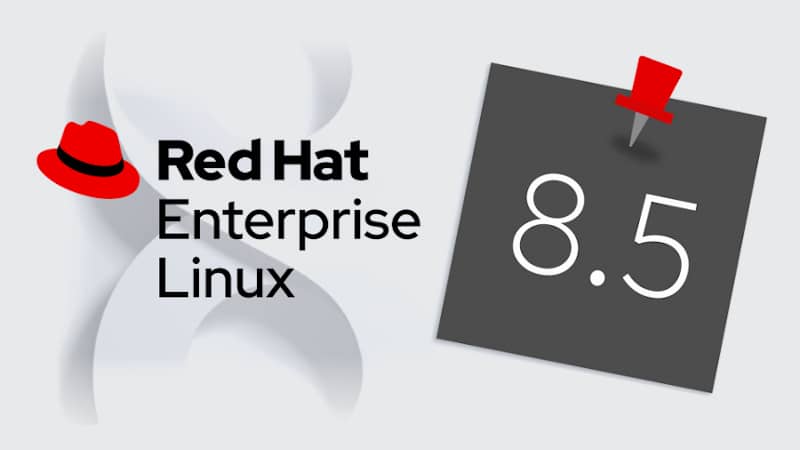Red Hat Enterprise Linux 8.5 released with following new features and improvements
Red Hat Enterprise Linux (RHEL) 8.5 has been officially released with a bunch of new features and improvements as listed here.- Community submission by Editor (9to6linux) on

Red Hat Enterprise Linux (RHEL) 8.5 has been officially released with a bunch of new features and improvements as listed below.
Red Hat announces the general availability of Red Hat Enterprise Linux (RHEL) 8.5 as the fifth maintenance update to the Red Hat Enterprise Linux 8 series.
The latest version of Red Hat Enterprise Linux comes with various new features, which includes Kernel live patching, Enhanced System Security Services Daemon (SSSD) logging, Network Time Security (NTS) for the Network Time Protocol (NTP), and other new improvements as detailed below:
Linux container improvements in RHEL 8.5
RHEL 8.5 continues the tradition of new features and improvements for running Linux containers. This release brings tooling that will add flexibility and reduce friction in running Podman in a wider range of environments.
Containerized Podman - The RHEL 8 Podman container image (rhel8/podman) is now GA and can help unlock the usage of Podman in cloud CI/CD systems, on WSL2 on Windows, under Docker Desktop on macOS, and (of course) on RHEL 6, 7 and 8. You can use the Podman container image to help develop and run other container images.
Verify container image signatures by default - In RHEL 8.5 users can pull container images with confidence. Out of the box, RHEL 8.5 will check container image signatures to verify that they are, in fact, from Red Hat and haven't been tampered with or manipulated.
Native OverlayFS as a Rootless container user - RHEL 8.5 offers better performance when building and running rootless containers, with native support for OverlayFS.
RHEL 8.5: Easier to manage and deploy
We continue to focus on ways to simplify and improve managing and deploying RHEL. In RHEL 8.5 we bring a number of automation and management tools to automate manual tasks, standardize deployment at scale, and simplify the day-to-day administration of their systems.
Enhanced web console performance metrics - Can help to identify performance problems. Whether you're looking to identify CPU, disk or network performance problems, the enhanced metrics available in the RHEL 8.5 web console can help you out. Additionally, you'll be able to more easily export your metrics to a Grafana server.
Ansible module for hardware management - With RHEL 8.5 you can use Ansible to manage settings of Intelligent Platform Management Interface (IPMI) for things like power state of a system and boot order of devices.
System roles for VPN and Postfix -You can reduce the time it takes to set up VPN and Postfix using system roles.
Part of managing systems is dealing with security and policy compliance. To that end, RHEL 8.5 has a number of features that will assist in managing security and compliance when deploying new systems or managing your existing infrastructure.
Kernel live patching on all Red Hat Enterprise Linux minor releases - Kernel live patching is also now available for the RHEL minor releases with the ability to access kernel live patches for a six month period after a specific kernel is released. This means more flexibility for customers as they strive to maintain security on their RHEL systems by applying critical and important security patches without rebooting.
Kernel live patching management via web console - You can manage kernel live patching from within the RHEL web console to reduce the complexity of performing critical maintenance. This new capability provides a simplified interface for applying kernel updates without having to reboot.
Enhanced System Security Services Daemon (SSSD) logging - Access enhanced SSSD user authentication logs, including details such as time to complete, errors, authentication flow, and configuration. This enhancement includes search capabilities so administrators can more easily analyze performance or configuration issues within the user authentication infrastructure.
Network Time Security (NTS) for the Network Time Protocol (NTP) - Apply the NTS standard, which provides cryptographic authentication of NTP servers. This authentication helps to prevent man-in-the-middle attacks that might compromise critical time-keeping services.
SQL server enhancements
Customers running Microsoft SQL Server on RHEL will see a number of enhancements to help configure, manage and operate RHEL more efficiently.
RHEL System Role for Microsoft SQL Server - Is available for RHEL 8.5. This system role allows IT administrators and DBAs to more quickly install, configure and tune SQL Server in an automated fashion.
The SQL Server Assessment API for Red Hat Insights - Helps provide an optimal user experience for system and database administrators, by delivering information from Microsoft's SQL Server assessment API. It helps provide best practices from Microsoft to evaluate the configuration of SQL Server and provides users with remediation capabilities for issues discovered via the API.
For developers and application support
Ultimately, RHEL is all about running your applications and infrastructure. As a solid foundation for building and running next-generation applications, RHEL 8.5 brings support for OpenJDK 17 and .NET 6.
OpenJDK 17 lets developers take advantage of new Java features, while also improving the stability of existing application environments. Noteworthy features in OpenJDK 17 include an enhanced pseudo-random number generator, which is a common basis for many cryptographic operations, algebraic data types which simplify how complex data can be modeled, and enforcement of strict floating-point consistency for better predictability of numerically sensitive applications.
OpenJDK 17 is also available as a RHEL Universal Base Image (UBI) container, giving developer teams new ways to try out and upgrade applications, and to use OpenJDK in CI/CD pipelines.
At the heart of .NET 6 are the final parts of the .NET unification plan that started with .NET 5.
.NET 6 is a long-term support release with a number of performance improvements. New in .NET 6 is C# support along with improved diagnostics and several new APIs including WebSocket compression and simplified cryptography.



